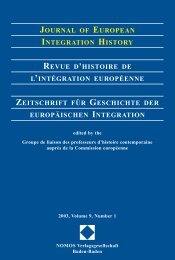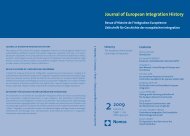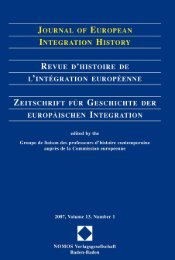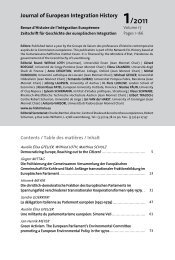journal of european integration history revue d'histoire de l ...
journal of european integration history revue d'histoire de l ...
journal of european integration history revue d'histoire de l ...
Create successful ePaper yourself
Turn your PDF publications into a flip-book with our unique Google optimized e-Paper software.
80<br />
Hans-Otto Frøland<br />
with the British from 1950 to 1959. In 1957 the government was also inclined to<br />
follow the British into a wi<strong>de</strong>r European free tra<strong>de</strong> area. After this failed, EFTA<br />
was a good solution because it united the Atlantic and the Nordic foreign policy<br />
orientations. A purely Nordic solution, which had been discussed since 1947,<br />
proved impossible without British participation. Thus, in accordance with the perspective<br />
that gives predominance to the geopolitical challenges, EFTA can be regar<strong>de</strong>d<br />
as re<strong>de</strong>mption <strong>of</strong> basic foreign policy orientation. However, the Norwegian<br />
authorities much preferred a process <strong>of</strong> European <strong>integration</strong> within the framework<br />
<strong>of</strong> NATO. This, among other issues, had been one <strong>of</strong> the reasons why in 1955 the<br />
government called for the expansion <strong>of</strong> NATO co-operation into civilian areas. 9<br />
The study <strong>of</strong> Norway's European <strong>integration</strong> policy and attitu<strong>de</strong>s adopted another<br />
perspective after the referendum in September 1972; one, which took into consi<strong>de</strong>ration<br />
domestic, constraints. The un<strong>de</strong>rlying question in this perspective was<br />
why the people did not share the authorities' inclination to join the Community.<br />
Scholars thus started to study the political mobilisation against EC membership<br />
and the socio-political conditions for its success. The negative outcome <strong>of</strong> the 1994<br />
referendum certainly confirmed the relevance <strong>of</strong> this perspective. What are the<br />
most significant results ensuing when adopting this new perspective?<br />
The membership issue activated an otherwise stable electorate. It produced rifts<br />
that cleaved through the political landscape polarised along the right-left axis. 10<br />
The basic trend was that those in favour resi<strong>de</strong>d in urban areas while rural resi<strong>de</strong>nts<br />
opposed. The lesser the urbanisation and the longer the distance to urban centres,<br />
the greater the opposition. The closer one came to Oslo, the greater the inclination<br />
to accept Norwegian EEC membership. 11 There was a no-majority in 387 out <strong>of</strong><br />
444 municipalities. The opposition prevailed most in small fishing communities in<br />
Northern Norway. The rifts could be interpreted as a socio-economic phenomenon,<br />
as the primary sector was localised in rural areas; as a socio-cultural phenomenon,<br />
due to the contrasts between urban and rural communities; and as a socio-political<br />
phenomenon, as there was a conflict between the elite and the rank and file. Together<br />
they were looked upon as a pr<strong>of</strong>ound cleavage between the centre and the periphery<br />
that had been reinforced throughout the 19th century. 12 A notable exception<br />
9. On policy towards NATO cf. O. RISTE, Was 1949 a turning point?, in: O. RISTE (ed.), Western<br />
Security: The Formative Years, Oslo, 1985, pp.128-149; R. TAMNES, The United States and the<br />
Cold War in the High North, Oslo, 1991; G. LUNDESTAD, The Evolution <strong>of</strong> Norwegian Security<br />
Policy: Alliance with the West and Reassurance in the East, in: Scandinavian Journal <strong>of</strong> History,<br />
Vol.17, 1992, pp.227-256; and M. BERDAL, The United States, Norway and the Cold War,<br />
1954-1960, Basingstoke, 1996.<br />
10. H. VALEN and S. ROKKAN, Norway: Conflict structure and mass politics in a European periphery, in:<br />
R. ROSE (ed.), Electoral behaviour: a comparative handbook, New York, 1974, pp.315-370.<br />
11. O. HELLEVIK and N.P. GLEDITSCH, The Common Market <strong>de</strong>cision in Norway: A clash between<br />
direct and indirect <strong>de</strong>mocracy, in: Scandinavian Political Studies, Vol.8, 1973, pp.227-235.<br />
12. Cf. H. VALEN, Norway: No to EEC, in: Scandinavian Political Studies, Vol.8, 1973, pp.214-226;<br />
and National Conflict Structure and Foreign Politics: The Impact <strong>of</strong> the EEC Issue on Perceived<br />
Cleavages in Norwegian Politics, in: European Journal <strong>of</strong> Political Research, Vol.4, 1976,<br />
pp.47-82.

















